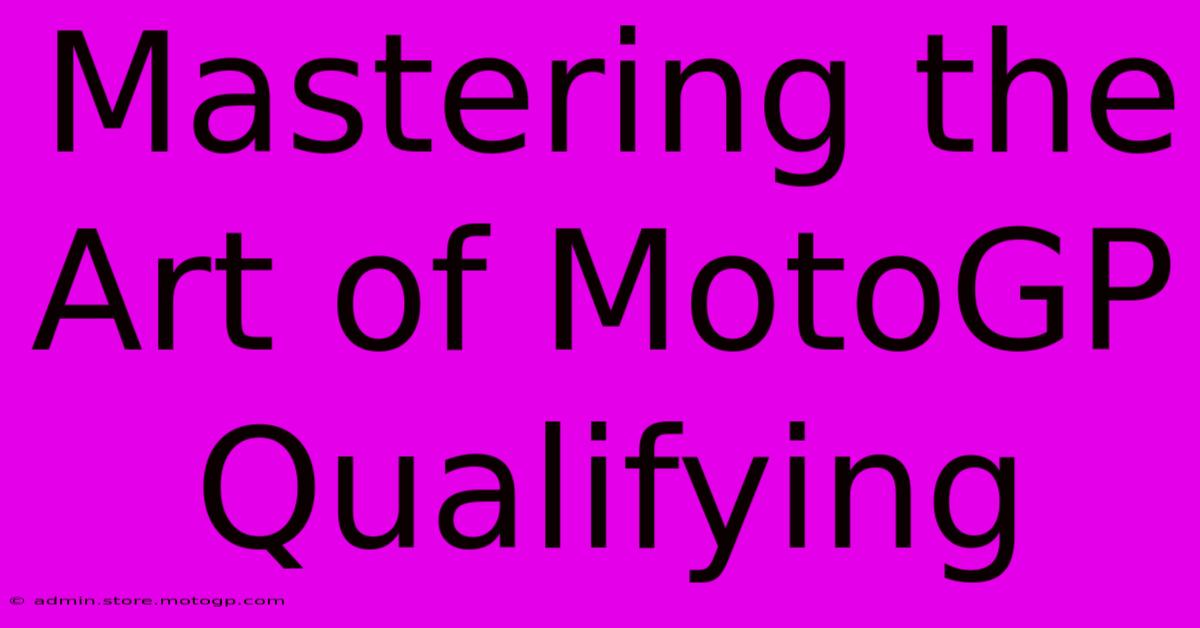Mastering The Art Of MotoGP Qualifying

Table of Contents
Mastering the Art of MotoGP Qualifying: From Grid Position to Race Victory
MotoGP racing is a brutal, unforgiving sport where even the smallest advantage can mean the difference between victory and defeat. While race strategy and rider skill are paramount, securing a strong grid position during qualifying is arguably the single most important factor in achieving success. Mastering the art of MotoGP qualifying is a complex process that demands a perfect blend of rider skill, bike setup, and strategic thinking. This article will delve into the intricacies of this crucial stage of the weekend, exploring the key elements that separate the front runners from the backmarkers.
Understanding the Qualifying Format
MotoGP qualifying is a multi-stage process designed to whittle down the field and determine the starting grid. The format often varies slightly from track to track, but generally follows this structure:
Free Practice (FP1-FP4): These sessions are crucial for gathering data, testing different setups, and familiarizing the riders with the track. While not directly part of qualifying, FP sessions lay the foundation for a successful qualifying performance. Teams analyze tire wear, electronics settings, and aerodynamic performance to optimize the bike for the qualifying runs.
Q1 (Qualifying 1): The riders who haven't achieved a top-ten time in the combined Free Practice sessions compete in Q1. This is a high-stakes session where only the top two riders progress to Q2. The pressure is immense, and even a small mistake can be devastating.
Q2 (Qualifying 2): The top ten riders from the combined Free Practice sessions, along with the two fastest from Q1, compete in Q2 to determine the final starting grid. This session is incredibly intense, with riders pushing their machines and themselves to the absolute limit to secure pole position. The slightest improvement in lap time can make a significant difference in grid placement.
Key Elements of a Successful Qualifying Performance
Several key elements contribute to a successful qualifying performance:
1. Bike Setup: A perfectly tuned motorcycle is essential for achieving optimal lap times. This includes everything from suspension settings and tire pressure to aerodynamic adjustments and engine mapping. Teams meticulously analyze data from the practice sessions to fine-tune the bike's setup for qualifying, often making small but crucial adjustments between sessions.
2. Tire Management: Choosing the right tires and managing them effectively is crucial. Riders must balance performance with tire longevity, ensuring they have enough grip for a fast qualifying lap without compromising performance for the race. This involves careful consideration of tire compounds and track conditions.
3. Track Knowledge and Line Selection: A deep understanding of the track is essential. Riders must know the ideal racing line, braking points, and apex speeds to maximize their speed and efficiency. This knowledge comes from experience and careful analysis of track data.
4. Riding Technique: Smoothness and precision are key during qualifying. Riders need to execute perfect corner entries and exits, smooth acceleration, and precise braking to achieve optimal lap times. Any mistakes or inconsistencies will cost valuable time.
5. Race Strategy and Risk Assessment: Qualifying is not just about setting the fastest single lap time. Riders must also consider race strategy and risk assessment. Pushing too hard and crashing in qualifying can have devastating consequences for the race.
6. Slipstream (Drafting): Taking advantage of slipstream is a crucial part of qualifying, particularly in Q2. Riding closely behind another rider can reduce aerodynamic drag and allow for significantly faster speeds on the straights. This requires precise timing and positioning.
Beyond the Lap Time: The Mental Game
The mental aspect of qualifying is often overlooked, but it's crucial for success. Riders need to remain calm under pressure, manage their focus, and avoid making mistakes due to anxiety or impatience. Mental preparation, including visualization and mindfulness techniques, can significantly improve performance.
Conclusion: From Pole to Podium
Mastering the art of MotoGP qualifying is a multifaceted challenge that demands a combination of technical expertise, strategic thinking, and mental fortitude. By understanding the format, optimizing bike setup, managing tires effectively, mastering track knowledge, and executing precise riding techniques, MotoGP riders can dramatically increase their chances of securing a favorable grid position, laying the groundwork for a potential race victory. The pursuit of pole position is a relentless battle, one that encapsulates the thrill and intensity of the sport.

Thank you for visiting our website wich cover about Mastering The Art Of MotoGP Qualifying. We hope the information provided has been useful to you. Feel free to contact us if you have any questions or need further assistance. See you next time and dont miss to bookmark.
Featured Posts
-
Us Gp Sprint The Art Of The Overtake
Feb 17, 2025
-
Austin Gp Sprint Race The Winning Formula
Feb 17, 2025
-
Uncover The Power Of Cota Lot H
Feb 17, 2025
-
Moto2 Standings 2025 The Definitive Ranking Of Riders
Feb 17, 2025
-
Moto 2 Bike Specs The Edge You Need
Feb 17, 2025
